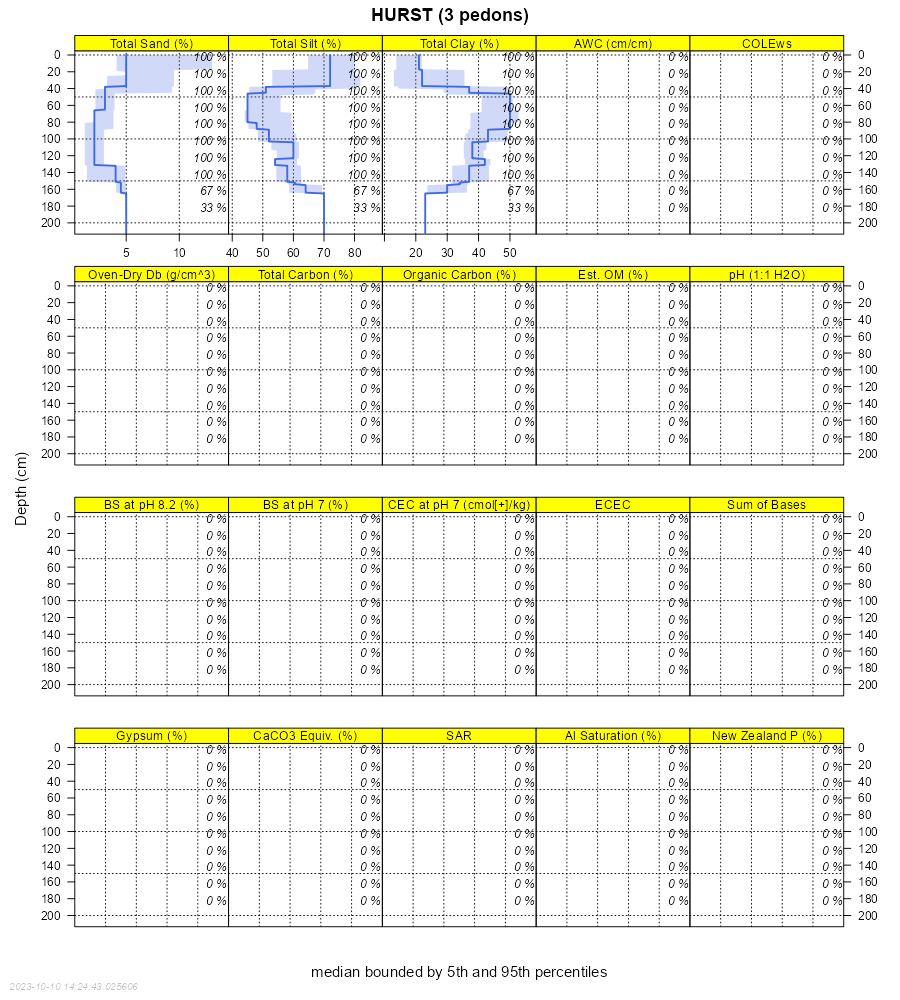| Hurst silt loam, 0 to 2 percent slopes, rarely flooded | 7338A | 516 | 602283 | n6qh | il003 | 2002 | 1:12000 |
Hurst silt loam, 2 to 5 percent slopes, rarely flooded | 7338B | 230 | 602284 | n6qj | il003 | 2002 | 1:12000 |
Hurst silt loam, 0 to 2 percent slopes, rarely flooded | 7338A | 318 | 175519 | 5wmx | il013 | 1986 | 1:15840 |
Hurst silt loam, 0 to 2 percent slopes, rarely flooded | 7338A | 1170 | 174670 | 2tbsd | il027 | 1992 | 1:15840 |
Hurst silt loam, 2 to 5 percent slopes, eroded, rarely flooded | 7338B2 | 535 | 174671 | 2tbsr | il027 | 1992 | 1:15840 |
Hurst silt loam, 0 to 2 percent slopes | 338A | 3527 | 806937 | 2tbsb | il055 | 2005 | 1:12000 |
Hurst silt loam, 0 to 2 percent slopes, rarely flooded | 7338A | 182 | 211726 | 739w | il061 | 1968 | 1:15840 |
Hurst silt loam, 0 to 2 percent slopes, rarely flooded | 7338A | 261 | 714015 | ryzr | il069 | 2003 | 1:12000 |
Hurst silty clay loam, 0 to 2 percent slopes, occasionally flooded | 8693A | 89 | 714059 | rz15 | il069 | 2003 | 1:12000 |
Hurst silt loam, 0 to 2 percent slopes | 338A | 8371 | 1537835 | 2tbsb | il077 | 2006 | 1:12000 |
Hurst silt loam, 2 to 5 percent slopes, eroded, rarely flooded | 7338B2 | 2945 | 1540809 | 2tbsr | il077 | 2006 | 1:12000 |
Hurst silt loam, 2 to 5 percent slopes, eroded | 338B2 | 2254 | 1539092 | 2tbsp | il077 | 2006 | 1:12000 |
Hurst silt loam, 0 to 2 percent slopes, rarely flooded | 7338A | 1403 | 1540791 | 2tbsd | il077 | 2006 | 1:12000 |
Hurst silty clay loam, 2 to 5 percent slopes, eroded, rarely flooded | 7338B2 | 98 | 728389 | sfyf | il083 | 2002 | 1:12000 |
Hurst silt loam, 0 to 2 percent slopes, rarely flooded | 7338A | 176 | 198909 | 2tbsd | il119 | 2001 | 1:12000 |
Hurst silty clay loam, 0 to 2 percent slopes, occasionally flooded | 8693A | 1878 | 808157 | w3yl | il127 | 2004 | 1:12000 |
Hurst silt loam, 2 to 5 percent slopes, occasionally flooded | 8338B | 317 | 184139 | 65lz | il133 | 1998 | 1:12000 |
Hurst silt loam, 0 to 2 percent slopes, rarely flooded | 7338A | 1627 | 1405913 | 2tbsd | il145 | 2005 | 1:12000 |
Hurst silty clay loam, 0 to 2 percent slopes, occasionally flooded | 8693A | 1198 | 608158 | ndv0 | il151 | 2003 | 1:12000 |
Hurst silt loam, 0 to 2 percent slopes, rarely flooded | 7338A | 120 | 607170 | nct4 | il151 | 2003 | 1:12000 |
Hurst silt loam, 0 to 2 percent slopes, rarely flooded | 7338A | 164 | 748990 | t4cz | il153 | 2004 | 1:12000 |
Hurst silt loam, 2 to 5 percent slopes, rarely flooded | 7338B | 62 | 748991 | t4d0 | il153 | 2004 | 1:12000 |
Hurst silt loam, 2 to 5 percent slopes | 338B | 1914 | 200475 | 2wcyp | il157 | 2001 | 1:12000 |
Hurst silt loam, 0 to 2 percent slopes | 338A | 1122 | 200474 | 2tbsb | il157 | 2001 | 1:12000 |
Hurst silty clay loam, 5 to 10 percent slopes, eroded, occasionally flooded | 8338C2 | 1626 | 183148 | 2tp2h | il163 | 1997 | 1:12000 |
Hurst silt loam, 2 to 5 percent slopes, eroded, occasionally flooded | 8338B2 | 1108 | 183147 | 2tbsq | il163 | 1997 | 1:12000 |
Redbud-Hurst silty clay loams, 5 to 10 percent slopes, severely eroded | 906C3 | 945 | 183186 | 64m7 | il163 | 1997 | 1:12000 |
Hurst silt loam, 0 to 2 percent slopes, occasionally flooded | 8338A | 800 | 183146 | 2tbsc | il163 | 1997 | 1:12000 |
Hurst silt loam, sandy substratum, 0 to 2 percent slopes, occasionally flooded | 8489A | 559 | 183155 | 2tbsn | il163 | 1997 | 1:12000 |
Hurst silt loam, 0 to 2 percent slopes | 338A | 5335 | 178875 | 2tbsb | il165 | 1974 | 1:15840 |
Hurst silt loam, 0 to 2 percent slopes, rarely flooded | 7338A | 1866 | 1528996 | 2tbsd | il189 | 2006 | 1:12000 |
Hurst silt loam, 0 to 2 percent slopes | 338A | 1425 | 1528944 | 2tbsb | il189 | 2006 | 1:12000 |
Hurst silt loam, 0 to 2 percent slopes | 338A | 3446 | 1478120 | 2tbsb | il199 | 2007 | 1:12000 |
Hurst silt loam, 0 to 2 percent slopes, rarely flooded | 7338A | 55 | 1710717 | 2tbsd | il199 | 2007 | 1:12000 |
Hurst silt loam, 2 to 5 percent slopes, eroded, rarely flooded | 7338B2 | 2 | 1902864 | 2tbsr | il199 | 2007 | 1:12000 |
Hurst silt loam, 0 to 2 percent slopes, rarely flooded | HuA | 472 | 1596187 | 1qkyx | ky602 | 1972 | 1:12000 |
Hurst silt loam, 0 to 2 percent slopes, protected | HrA | 396 | 1596189 | 1qkyz | ky602 | 1972 | 1:12000 |
Hurst silt loam, 0 to 2 percent slopes, rarely flooded | 66039 | 4275 | 184548 | 6615 | mo183 | 1979 | 1:24000 |













